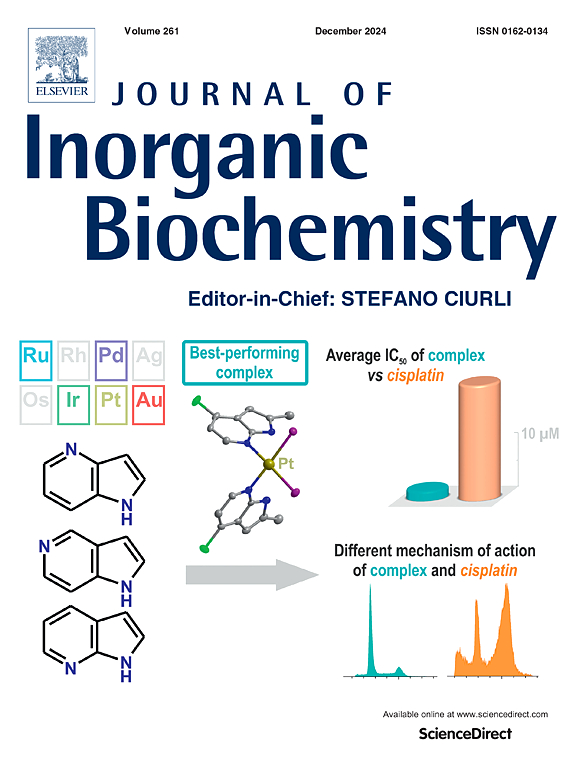新型铂(IV)前药顺铂轴向偶联大麻二酚诱导线粒体功能障碍,协同增强抗肿瘤作用
IF 3.2
2区 化学
Q2 BIOCHEMISTRY & MOLECULAR BIOLOGY
引用次数: 0
摘要
经典的以顺铂为基础的化疗药物广泛应用于临床。近年来,新型铂基抗肿瘤药物的研究重点是用相对惰性的铂(IV)前药取代经典的顺铂样铂(II)配合物,以克服耐药和减少毒副作用。基于大麻二酚(CBD)优异的生理药理活性,本研究设计合成了新型Pt(IV)前药W1-W6,这是顺铂与CBD及特异性活性小分子的轴向偶联物。这些前药对肿瘤细胞系的抗肿瘤活性更显著。其中,多功能Pt(IV)前药W5,结合CBD和PDK抑制剂DCA,对铂敏感和顺铂耐药肿瘤菌株均表现出优异的活性。W5对A549R肿瘤菌株的IC50值为8.53±0.76 μM,显著高于顺铂组,是单用CBD活性的3.64倍,具有较强的协同抗肿瘤活性,具有克服顺铂耐药的潜力。在A549R细胞中,GSH减少W5,释放CBD和Pt(II)。Pt(II)与DNA结合,诱导损伤并抑制修复,而CBD激活促凋亡蛋白,导致线粒体功能障碍。同时,W5降低ROS清除剂的水平,引发内质网功能障碍。这三种机制协同促进肿瘤细胞凋亡,克服耐药性。本设计通过轴向功能化整合多种机制,突破传统铂类药物单独靶向DNA的局限,通过调节代谢、干预免疫微环境实现协同效应。本文章由计算机程序翻译,如有差异,请以英文原文为准。

The novel platinum(IV) prodrug of cisplatin axially conjugated with cannabidiol induces mitochondrial dysfunction and synergistically enhances anti-tumor effects
Classical cisplatin-based chemotherapeutic drugs are widely used in clinical practice. In recent years, novel platinum-based antitumor drugs have focused on replacing classical cisplatin-like Pt(II) complexes with relatively inert Pt(IV) prodrugs to overcome drug resistance and reduce toxic side effects. Based on the excellent physiological and pharmacological activities of cannabidiol (CBD), this study designed and synthesized novel Pt(IV) prodrugs W1-W6, which are axial conjugates of cisplatin with CBD and specific active small molecules. These prodrugs demonstrated more significant antitumor activity against tested tumor cell lines. Among them, the multifunctional Pt(IV) prodrug W5, conjugated with CBD and the PDK inhibitor DCA, exhibited excellent activity against both platinum-sensitive and cisplatin-resistant tumor strains. The IC50 value of W5 for the A549R tumor strain was 8.53 ± 0.76 μM, significantly higher than that of the cisplatin group and 3.64 times the activity of CBD alone, demonstrating strong synergistic antitumor activity and potential to overcome cisplatin resistance. W5 is reduced by GSH in A549R cells, releasing CBD and Pt(II). Pt(II) binds to DNA, inducing damage and inhibiting repair, while CBD activates pro-apoptotic proteins, leading to mitochondrial dysfunction. Simultaneously, W5 reduces the levels of ROS scavengers, triggering endoplasmic reticulum dysfunction. These three mechanisms synergistically promote tumor cell apoptosis and overcome drug resistance. This design integrates multiple mechanisms through axial functionalization, breaking through the limitation of traditional platinum drugs targeting DNA alone, and achieves synergistic effects by regulating metabolism and intervening in the immune microenvironment.
求助全文
通过发布文献求助,成功后即可免费获取论文全文。
去求助
来源期刊

Journal of Inorganic Biochemistry
生物-生化与分子生物学
CiteScore
7.00
自引率
10.30%
发文量
336
审稿时长
41 days
期刊介绍:
The Journal of Inorganic Biochemistry is an established international forum for research in all aspects of Biological Inorganic Chemistry. Original papers of a high scientific level are published in the form of Articles (full length papers), Short Communications, Focused Reviews and Bioinorganic Methods. Topics include: the chemistry, structure and function of metalloenzymes; the interaction of inorganic ions and molecules with proteins and nucleic acids; the synthesis and properties of coordination complexes of biological interest including both structural and functional model systems; the function of metal- containing systems in the regulation of gene expression; the role of metals in medicine; the application of spectroscopic methods to determine the structure of metallobiomolecules; the preparation and characterization of metal-based biomaterials; and related systems. The emphasis of the Journal is on the structure and mechanism of action of metallobiomolecules.
 求助内容:
求助内容: 应助结果提醒方式:
应助结果提醒方式:


